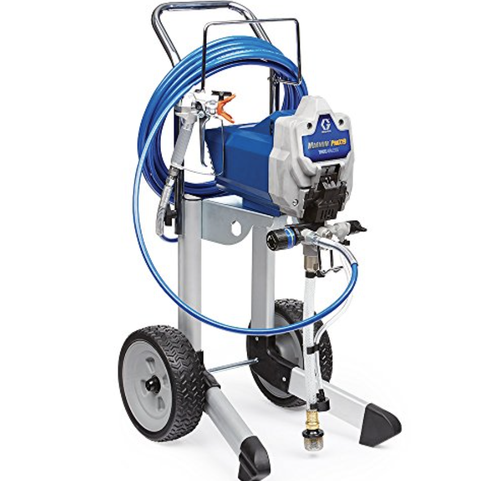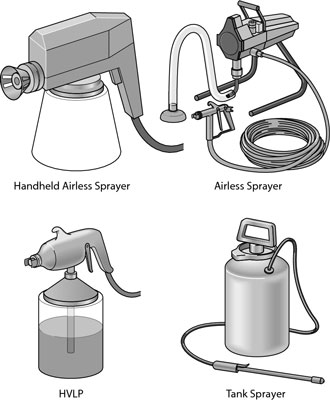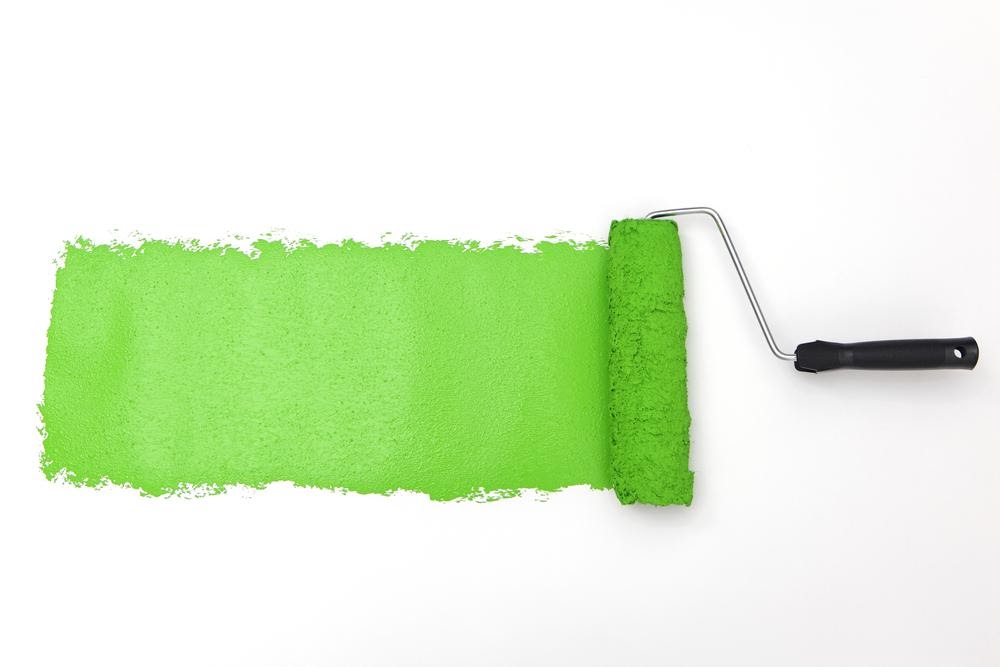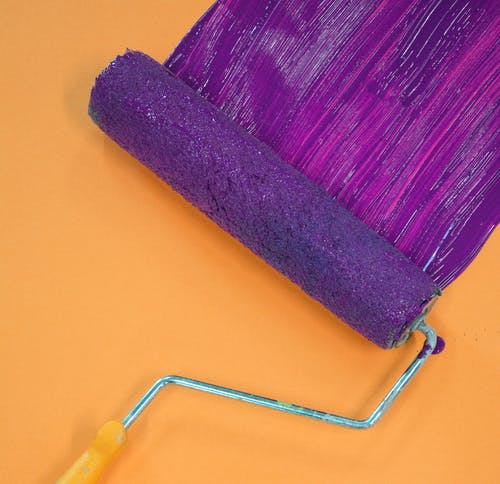Painting undeniably makes a surface stand out. Moreover, good paintwork can increase the value of what you are painting, especially a house or its fixtures.
But overall, the secret to getting the most from painting is using the right technique. That brings us to paint sprayers and rollers, two of the most effective painting methods.
The question on everyone’s mind is, which is better?’ We have found that one is ideal for users looking for high-speed painting and more precision in larger projects, and the other for users looking to complete smaller projects at a lower cost.
TL;DR: Paint Sprayer vs Roller

Paint Sprayer

Roller

Pros
Paint Sprayer
More durable
Fine and quality finish
Efficient by up to 90% for air-powered models
Roller
Easy to set up
More affordable
Beginner-friendly
Cons
Paint Sprayer
Slightly costlier
Airless models use a lot of paint
More challenging and more expensive to maintain
Roller
Not as quick as sprayers
Cannot penetrate narrow and tighter spaces
Best For
Paint Sprayer
Users looking to paint large surfaces in less time
Cars, furniture, walls, fences, and exterior fixtures
Roller
Users looking to paint smaller surfaces on a tight budget
High surfaces like ceilings, large surfaces like walls, and medium surfaces like doors and cabinets
What is a Paint Sprayer, and How Does it Work?
Paint spraying is a painting method used to apply paint onto the surface by spraying, just like the name suggests. A paint sprayer is a fluid-handling device that relies on pressure from a motorized pump or compressed air from a turbine system or an air compressor to transfer paint onto a surface.
Sprayers can hold more paint and are mostly used to restore colors on surfaces and make them look more appealing.
Paint sprayers have many benefits. They reduce workload and are thus time-effective.
But to get the most out of the paint, you have to ascertain that the surface is clean and smooth.
Though paint sprayers may have a few setbacks, like needing careful maintenance, they are worth every penny.

Types of Paint Sprayers
Generally, there are three primary types of paint sprayers, which include:
Conventional Compressed Air Sprayers
Compressed air sprayers use compressed air to spray out paint through a nozzle. Typically, these sprayers feature a spray gun, a compressor can, and a high-pressure hose.
The advantage of these spray guns is that you can customize them to use circular, horizontal, or vertical spray patterns to create appealing finishes. These sprayers are pretty easy to use, making them best for novices.
Conventional compressed air sprayers are generally best for painting cars.
Airless Paint Sprayers
Airless paint sprayers are electric pump-powered sprayers that spray paint onto surfaces through a tip under high pressure.

Overall, airless paint sprayers are best for working with more viscous paints, especially latex paints. But still, you can use them to spray lighter and thinner materials like varnish and wood stain.
HVLP (High-Volume Low-Pressure) Paint Sprayers
HVLP sprayers work under low pressure but spray more paint, thus the name high-volume low-pressure. Their working mechanism reduces paint wastage, making them best for thin paint or spray materials.
Overall, HVLP sprayers are best for painting doors, walls, and hidden areas like the house corners.
LVLP (Low-Volume Low-Pressure) Paint Sprayers
LVLP sprayers are the direct opposite of HVLP sprayers. Unlike HVLP, LVLP paint sprayers pump less amount of paint under low pressure. As a result, they suit DIYers more as they only need basic pressure, less than 10 psi.
Design-wise, they are much smaller, meaning they only handle smaller projects like painting furniture and interior walls.
What is a Paint Roller, and How Does it Work?
Paint rollers are tools used to paint flat surfaces evenly and efficiently through repeat rolling action.
A paint roller usually consists of two parts – the frame and the cover.
The cover usually attaches to the structure and is responsible for rolling over surfaces when applying the paint. There are many paint roller types on the market, and for that reason, it’s wise to research to identify the one that suits you the most.
Rollers are a better alternative to paintbrushes because they provide smoother finishes and cover small and more significant surfaces.
You can use rollers to paint doors, walls, high-rise ceilings, and many other surfaces.
Though rollers come with numerous advantages, they are not ideal for painting corners or joints.

Types of Paint Rollers
Below are different types of paint rollers:
Manual Paint Rollers
Manual paint rollers are the most common paint rollers on the market. They come with handle extensions that allow you to reach high-rise surfaces like the ceiling, even without a ladder.
They are suitably used to paint large areas as they hold more paint.
Pad Paint Rollers
Pad paint rollers tend to be the most effective rollers for painting edges and trims. They feature a high-absorbent pad and usually apply paint in even and straight strokes.
People use them mostly for painting ceilings. These rollers can lie flat on surfaces; hence they paint better than their counterparts.
Mini Hot Dog Rollers
As their name suggests, mini hot dog paint rollers have a shape similar to a hot dog. These rollers are steadily gaining popularity. They paint even in areas where the other types cannot reach, such as cupboards, rolling doors, and toilet walls.
Textured Paint Rollers
Textured paint rollers have features that apply textured coats onto surfaces. They have unique covers that assume specific patterns embedded in them. They can assume stone, tile, wood grain, among many other patterns. They are overall better suited to large surfaces like ceilings and walls.
Relevant Characteristics Between Paint Sprayers and Rollers
Paint Sprayer vs. Roller
Compare by tapping or clicking below!

Finish Quality
Paint Sprayer
High-quality finish
Roller
Quality finish
Paint Usage
Paint Sprayer
Use more paint
Roller
Use moderate paint
Project Size
Paint Sprayer
Mostly large surfaces
Roller
Both large and small surfaces
Coverage
Paint Sprayer
Smooth coverage
Roller
Smooth coverage
Speed
Paint Sprayer
Fast
Roller
Not as fast as a sprayer
Clean-up
Paint Sprayer
Time-intensive
Roller
Easy and fast clean-up
Cost
Paint Sprayer
Expensive
Roller
Affordable
Painting Flexibility
Paint Sprayer
Highly flexible
Roller
Fairly flexible
Ease of Use
Paint Sprayer
Less beginner-friendly
Roller
More beginner-friendly
Similarities and Differences
When looking at paint sprayers and rollers, they share several features that make it hard to choose between them. For example, both paint application methods promise smooth coverage and can take on large surfaces.
But if you look closely, a few features set them apart, such as paint usage, speed, ease of cleaning, and cost.
Here’s a breakdown of their similarities and differences.
Paint Sprayer and Roller Differences
Let’s look at the differences under the following:
Paint Usage
Sprayers use more paint, which means you have to buy more. There is even more wastage when spraying. Generally, sprayers use about 33% more paint than rollers.
So, if you want to save on the paint cost, rollers are a better option.
Coverage
Sprayers can paint the narrowest spots because they have better coverage. They also can take on larger surfaces. You, however, have to clean the surface and make sure it’s smoother for the paint coat to be smoother.
Paint rollers, in contrast, are only best for larger surfaces like ceilings and walls. You may not have an easy time taking on thin sections like the wall edges.
Speed
Generally, it takes time to assemble a paint sprayer, which is a downside. But once you master how to do it, the technique is quicker. So, you are likely to paint faster with a paint sprayer when everything is set up.
Rollers, on the other hand, do not involve a lot of assembly work. You only need to attach the cover/roller to the frame, and that is it. However, in terms of painting, they aren’t as quick as paint sprayers.
Cost
While paint rollers are affordable and budget-friendly, sprayers cost much more. Entry-level paint sprayers cost about $100, and high-quality ones can cost up to $1,000.
You are, however, more likely to spend less with paint rollers.

Painting Flexibility
When using a roller, it doesn’t necessarily force you to complete a given task. In that case, you can wash the roller or lock it up in a bag to work another day.
That is unlike a sprayer. With a sprayer, you have to commit to continuing painting until the paint runs out. If you leave the paint in the sprayer, it can dry and clog the hose and tips.
Ease of Use
Paint spraying is not as easy as the name suggests. It may take tons of errors before getting a smoother finish, and as a result, it’s less beginner-friendly.
In contrast, paint rolling is easy as you need to pass the roller (paint cover) across the surface, and that’s it.
Paint Sprayer and Roller Similarities
Below are some similarities between rollers and paint sprayers.
Project Size Suitability
Both paint rollers and paint sprayers can paint larger surfaces. However, the sprayer is quicker than the roller and has the advantage of reaching the corners and other areas that the roller cannot reach.
Clean-Up
Both options are messier. Whenever you use a roller or sprayer, you have to cover the areas you are not painting, like the floor and windows. If you don’t, you’ll have a lot of work cleaning up the mess later.
You can use newspapers, clothes, or other materials to cover the surfaces you won’t be painting.
When it comes to cleaning, rollers are easier to clean compared to sprayers. However, sprayers with adapters for a garden hose will have about the same ease of cleaning as rollers.
Finish Quality
Both rollers and paint sprayers can deliver quality finishes if you master how to use them. The trick is to know how to use each method.
Even though the two techniques use different tools, they promise quality finishes, thus best for professional use.
What About Brush Painting?
Brush painting is a traditional technique where you use a brush to apply paint onto surfaces. Even though rollers and sprayers are increasingly becoming popular, brush painting remains a viable choice, especially for budget DIYers
Though it’s considered slower than rollers and sprayers, most painters prefer using brushes to paint their walls. That’s because they allow them to create more custom looks, which is often not the case with rollers or paint sprayers.
Brush painting is also not as messy as the others. It’s always a good idea to cover the surfaces that you won’t be painting.
You can also use brushes to paint detail areas like edges and corners, just like paint sprays. They are also flexible and small, hence reducing paint wastage.
Brushes also come in different types, which include:
- Polyester/nylon brushes – These are best for water-based paints
- Natural brushes – These are best for oil-based paints
Important To Note:
It’s essential to choose a brush according to your need and preference. High-quality paint brushes will hold more paint; hence they apply evenly, promising more quality finishes.
Brush sizes from 0.5-6 inches, making it easier for you to choose a size according to your painting task. Half to 2-inch brushes are for painting smaller surfaces like louvers and railings, while 3 to 6-inch brushes are ideal for larger surfaces like walls and furniture.
Moreover, it’s also good to buy a brush that you can comfortably hold by the handle. Doing so will make the project enjoyable and reduce hand fatigue.
When to Use a Paint Sprayer vs Roller?
If you want is to paint fast and get quality results, spray paint will save you time. People commonly use paint sprayers where rollers cannot reach, like the edges, crevices, and tight areas.
Rollers, on the other hand, can cover large, flat, and high-rise surfaces efficiently. That includes walls and ceilings. Rollers are generally beginner-friendly and easy to assemble.
Rollers also give better finishes while using less paint, making them suitable for DIY use. Besides, they allow you to embed features on surfaces, making them ideal for DIY use.
When You Should Use a Paint Roller
If you want to paint high-rise surfaces like the ceiling or large surfaces like walls, paint rollers are a good choice. They are also suitable for more minor objects like doors and fences.
But generally, they give larger surfaces a better finish. If you are a beginner, painting using a roller is more accessible as the assembly is quicker.
In terms of setting, paint rollers are a better choice for indoor use. Overall, rollers suit DIY enthusiasts better as they embed different patterns and styles according to your preference. They are also great for painting on flat surfaces.
When You Should Use a Paint Sprayer

If you are looking for high painting speed, then a paint sprayer is what you should get. All you need is to fill the paint bucket or cup with paint, and you will be all ready for the task.
Also, sprayers are a better choice if you work on areas with crevices, curves, and corners as they penetrate deeper.
In addition to more petite and tight surfaces, paint sprayers can paint medium surfaces like doors and cabinets and larger ones like car bodies and walls.
In terms of setting, people mostly use sprayers outdoors, but you can still use them indoors.
Overall, if you worry about breaking your back after working for hours, paint sprayers suit you more. They are quicker in the application and support upright painting positions more, thus eliminating the risk of backache.
Bottom Line
Having compared paint sprayers and rollers, you now know what to get. But as a recap, a paint sprayer is best for painting large surfaces much faster while giving you a quality finish.
On the other hand, rollers are best for high-rise surfaces and large and small surfaces, especially when you are on a limited budget.
Overall, you have to select wisely by determining factors like project size, cost, coverage, and painting speed.
People Also Ask
Since paint sprayers and rollers have a lot in common, it is normal to have a few questions about the two.
Hopefully, we have explored all the burning questions you had about the two painting techniques. Below are more questions that people often ask about rollers and paint sprayers.
Spraying usually uses more paint. So, if you decide to use paint sprayers, you have to dig deeper into your pocket. Spray painting leads to paint wastage since not all the paint gets onto the surface. For example, an airless paint sprayer transfers 40 to 50 percent of paint.
If you are looking to save on paint costs, go for rollers.
Spray painting is faster, but the issue is assembling the tools, which can take time. It takes time to learn how to set up a paint sprayer quicker. But once you do that, the process is faster as paint spraying is more immediate.
Rollers, on the other hand, are quick to assemble. You only need to attach the cover or roller to the frame. However, when it comes to painting, they are not as quick as sprayers.
Happy painting!
